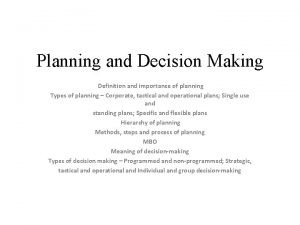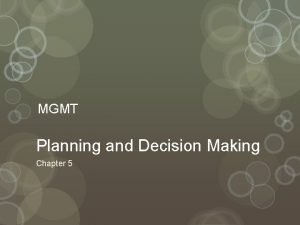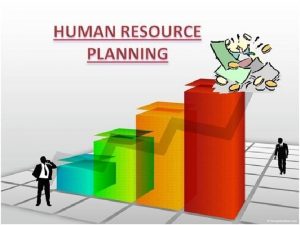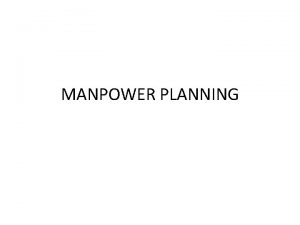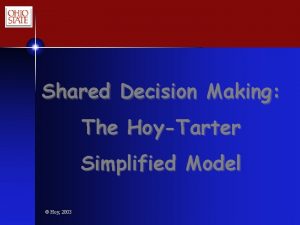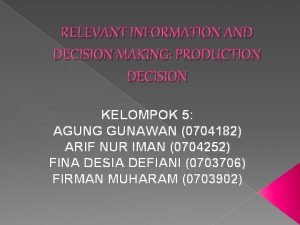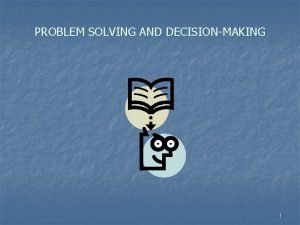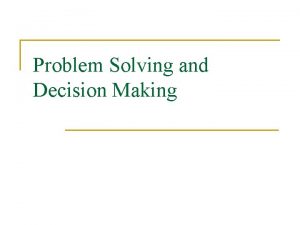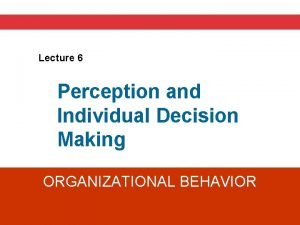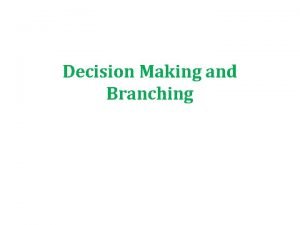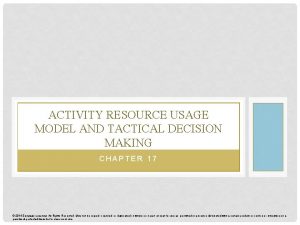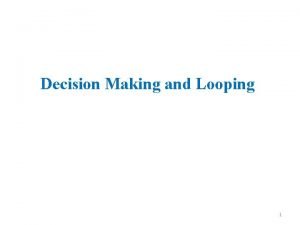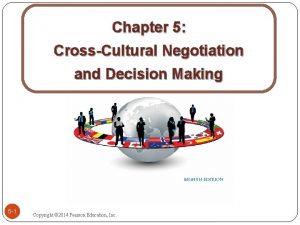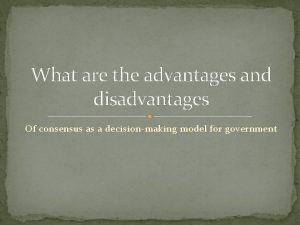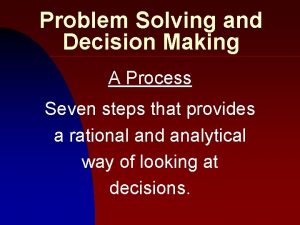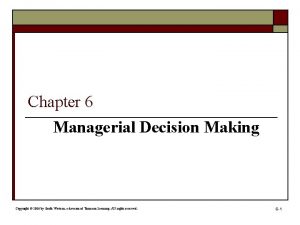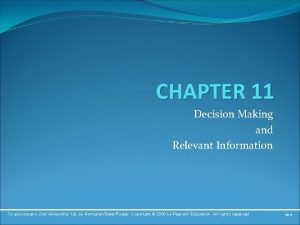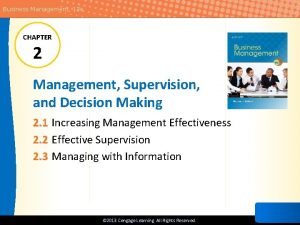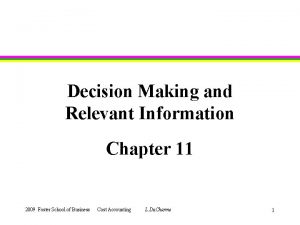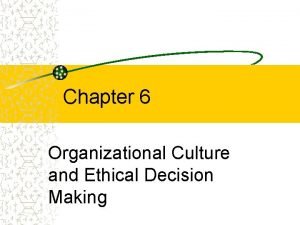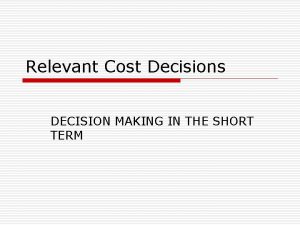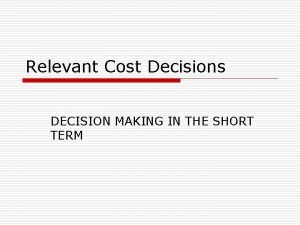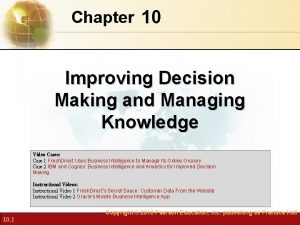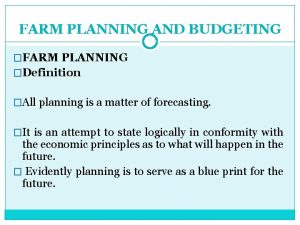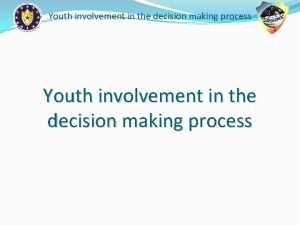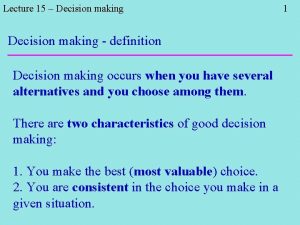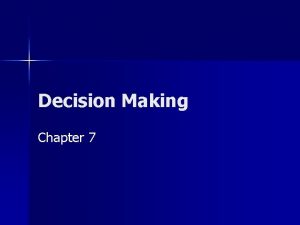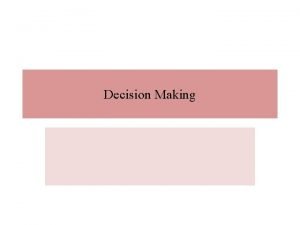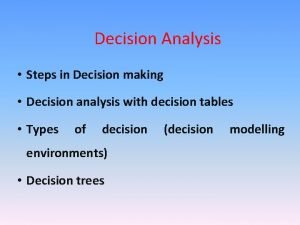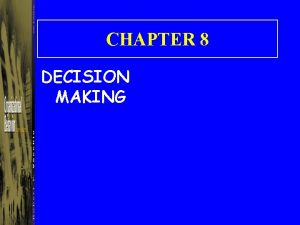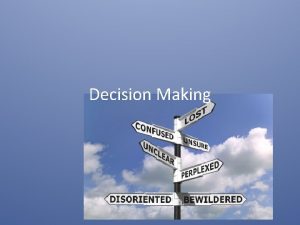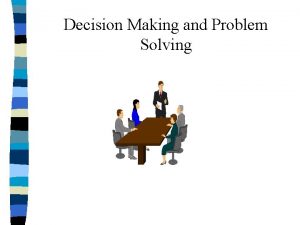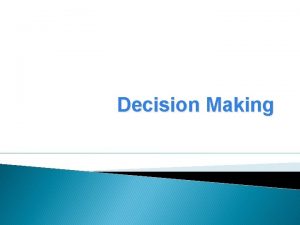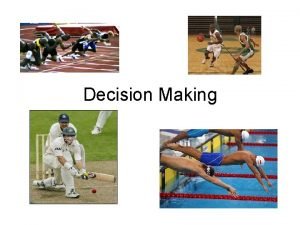Planning and Decision Making Definition and importance of


























































- Slides: 58

Planning and Decision Making Definition and importance of planning Types of planning – Corporate, tactical and operational plans; Single use and standing plans; Specific and flexible plans Hierarchy of planning Methods, steps and process of planning MBO Meaning of decision-making Types of decision making – Programmed and non-programmed; Strategic, tactical and operational and Individual and group decision-making

Introduction Ø It is the first/ primary function of the management of every organization. Ø It affects all the functions of management. Ø It is a process of setting goal, establishing a course of action, implementing the action plans and attaining the goals. Ø It is the key factor of a manager to organize activities, people, resource effectively and efficiently. Ø Planning is when a person thinks of something is to be done & prepares ways to perform the activity.

Definition • Koontz and O, Donnell(1979)- “ planning is an intellectual process, the conscious determination of courses of action, the basis of decisions on purpose, facts, and considered estimates”. • Dalton E. Mc. Farland(1983)- “planning is that part of management which attempts to define the organisation’s future’s. ”

Characteristics of planning • Planning is goal-oriented: – It is made to achieve desired objective of business. – It identifies the action that leads to desired goals quickly and economically. • Planning is looking a head: – It requires peeing in future, analyzing it & predicting it. – Planning is based on forecasting( expected future event) – It is mental perdisposition of things to happen in future. • Planning is intellectual process: – Planning is mental exercise involving creative thinking, sound judgement and imagination, but not a mare guess work – A manager can prepare sound plans only if he has sound judgement, foresight and imagination. Conti……

• Planning involves choice and decision making: – As there are various alternative of planning only one possible course of action, there is no need planning because there is no choice. – Thus, decicion making is an integral part of planning. – Managers are surrounded by number of alternative, they have to pick the best depending upon requrements and resources of the enterprise. • Planning is the primary function of the management: – It lays foundation for other function of management. – It serve as a guide for organizing, staffing, directing, controlling. – Alll the function of management are performed within the framework of plans laid out thus it is primary function

• Planning is pervasive: – It is required at all level of management and in all departments of enterprise. It exist everywhere. – The top level may be concerned about planning the organization as a whole whereas the middle level may be more specific in department plans and the lower level plan implementation of the same. • Planning is continous process: – It is never ending function due to the dynamic business environment. – It never comes into end till the enterprise exists issues, problems may keep cropping up and they have to be tackled by planning effectively.

Planning is designed for efficiency: It leads to accomplishment of objectives at the minimum possible cost reduce wastage of resources and ensures adequate and optimum utilization of resources. A plan is worthless or useless if it does not value the cost incurred on it. It leads to proper utilization of men, material, methods and machine. Planning is flexible: Since planning is unpredictable, planning must provide enough room to cope with the changes in customer’s demand, competition, government policies etc.

Importance of planning 1. Focus on goal: – Planning helps to draw the attention of the managers and employees to the defined objectives. – It defines clear link of action and responsibility. – It facilitates in bringing unity in action and coordination among all the units of works. 2. Reduces uncertainties: – Planning helps to forecast the future events and anticipate future uncertainty. – It reduces the risks& ucertainties caused by change in business environment. – It helps in developing strategies and action plans that are necessary to overcome the uncertainties.

3. Maintain effective control: – The control function of management is directly linked to planning. – It helps to evaluate the actual achievement and identify the deviation between planned and actual performance. – It makes control effective and meaningful. 4. Promotes innovation and creativity: – Planning encourages innovation thought & creative action among the managers. – It contribute in motivating and developing among employees. – It contribute in developing innovative ideas and creative actions. 5. Improves organizational efficiency & effectiveness: – Planning is selecting but course of action from various alternative courses. – It deals with maximum productivity and minimum cost of output. – It help in utilizing available resources in the best possible way.

6. Avoids business failure: – The basic motive of planning is to overcome business failure. – Strategies and plans are developed overhand to avoid the problems. – Thus it reduces business failure.

Limitation of planning • Inaccurcy: – The information and varaibles of plan have to be updated frequently which is not always possible. – The longer the plan period, the lesser the accuracy and reliability of information. – The planning involves forcasting for long-term future. As the overall environment change, the past information become meaningless over time. • Expensive process: – It requires extra efforts and time for collecting information, evaluating the alternative and forecasting. – Experts have to be hired to evaluatethe alternative and selecting the best course of action. – Extra bubjet have to be managed beside the normal investment. Conti….

• Ineffective: – Planning is only as good as the inputs used. – In the time of emergencies, planning has no meaning as on-the-spot decisions are taken. – Confusion among the manager about different dimensions and expectation, ultimately affects effective plan implementation. • Based on certain assumptions: – Plans are formulated on the basis of certain assumptions – When premises do not remain the same the overall plan of the organization is affected. • Based on actions: – Thinking and deciding is advance, is slow intellectual exercise, therefore it will likely to delay in action – During emergencies and crisis period, organizational plans have to be abandoned. – Many managers may not have the sufficient time for such exercise. Conti……

• Incomplete information: – The manager maynot be able to colleet the required information needed for planning. – The informtion may not be available in time an it’s reliability trnds to be suspecious. – Sometimes, the information and assumptions on which the plan is based may change. • False sense of security: – The variables used for planning keep on changing and management may not include the changes in plans. – This promotes false sense of security against uncertainty or risks. • Rigidity: – With change in environment plans have to be reversed frequently so managers and employees find it frustrating.

Methods of planning • Organization adopt different methods of planning for the proper management and to achieve the organizational goal. Methods of planning varies from one organization to another. The different methods of planning are: 1 Top- down method Ø Only top managers are involve in all aspects of planning Ø This method assumes that only top level managers have sufficient knowledge, skill and authority to formulate effective plan and policies. Ø Middle and first line manager do not play any role in plan formulation. Their role is to follow the direction given by top level managers. Ø This method is not commonly used in all organization.

2. Bottom – up method Ø Opposite to top- down method. Ø Plan proposals are initiated and developed at the first line management. Ø After the opinion of the button line come up to the top managament, these are consolidated, discussed , analyzed and compared with the mission of the organization. Ø Finally compromises and adjustment are made and the organizations plan are finalized. 3. Composite method Ø Combination of top-down and bottom up methods of planning. Ø Both top level management & first line management play equal role in plan formulation. Ø Top level managers review, modify and finalize the corporate plan in consultation with appropriate managers at middle and first line. Ø Involvement of every level managers and employees increases their motivation and commitment to their work.

Process/steps of planning • • Analyze opportunities Establishment of objectives Establishment of planning premises Determining& Evaluation of alternatives Selecting a course of action Formulate action plan Implementation plan Reviewing the planning process.

Hierarchy of planning

Hierarchy of planning Mission Goals Strategics Policies Procedures Rules Programs Budget

Hierarchy of plan 1. Mission: It is theme of the organization. Ø It clears what the organization want to provide to the society. Ø An organization’s mission is the purpose and philosophy that will drive it over a longer period of time, usually five to ten years. Ø A mission defines organization’s business and also serves as the basis for all planning. 2. Goals: It refer to the planned results to be achieved. Ø It specify who and whom should accomplish it. Ø It must be within the mission of the organization.

3. Strategies: It is a master plan defining how will an organization achieve its mission & goals. Ø It identifies basic long term objectives of organization & adopts course of action and allocation of resources for fulfilling goals. 4. Policies: Policy is comprehensive guideline for decision making. Ø Links formulation of strategy with its implementation. Ø It supports the mission, goals, and strategies. 5. Procedures: It describes the step to be taken for performing a task in detail. Ø It indicates how a policy is to be implemente like a guide

6. Rules: Rules are strict guides that are to be obeyed by all members of the organization. Ø It is essential to operate an organization in an orderly way Ø It establishes discipline and uniformity in work. 7. Programs: It is statement of all essential activities to accomplish a single plan. Ø It consists of complex set of goals, procedures, rules, resource flow in aggregate that are designed to accomplish. 8. Budget: It is a short –term financial plan. Ø It is the basis of measuring actual performance achieved with that of standard. Ø It is designed to allocate the resources of the organization.

Types of plan On the basis of hierarchy Strategic plan Tactical plan On the basis of use Single use plan Standing use plan On the basis of flexibility Flexible plan Specific plan Mechanization plan

PLAN Ø A plan would include ways to accomplish the goals, a timetable for the planned action, and a cost projection. Ø A plan serves as the foundation for all organizational activities. Ø From the analysis of information, the manager visualizes and formulates the schedule of activities and allocates the resources needed for reaching goals and objectives. Ø A document stating the goals, outlining the actionoriented strategies to attain these goals and assigning organizational resources to attain them.

Managerial Hierarchy and the planning system Top Strategic plan Manages Middle Tactical plan Managers Lower level Managers Mechanization plan

Strategic plan Ø Strategic plans are also known as “grand plan” Ø It is long term plan prepared by the top level management. Ø It outlines decisions of resources allocation, priorities, and action steps necessary to reach strategic goals. Ø It aims at internal strength and weakness to change in the external environment.

Tactical Plan Ø It is the subdivision of strategic plan which is prepared by departmental manager(middle level manager). Ø They are concerned more with actually getting things done that with deciding what to do. Ø It is based on priority of work and focuses on allocating resources on the basis of program. Ø It is medium term plan prepared to perform activities like production, finance, marketing , personnel, and others.

Mechanization /Operational Plan Ø It is short term plan prepared by the lower level manager. Ø It is consistent with tactical plan. Ø It is specific plan of each and every activities of the unit. Ø It involves a schedule of each unit of work to implement a tactical plan. Ø It concentrates on the best use of available resources

Single Use Plan Ø Such a plan is prepared for a specific purpose in non programmed situation. Ø It is prepared for non-repetitive activities. Ø After completion of the defined objective such a plan becomes worthless. Ø The examples of such a plan is program and budget.

Standing Use Plan Ø Such a plan is prepared for programmed decision making situation in an organization. Ø This plan gives broad guidelines for repetitive activities. Ø Such plan once developed will be implemented in the organization to achieve organizational objectives in different activities. Ø The examples of such a plan are objectives, rules, policies, procedures and strategy.

Specific plan • Specific plans are clearly defined plans. • It is developed for a particular department or unit about the activities to be performed. • In this plan, members of an organization are clear about the task to be performed and the resources to be used. • It is a tool for the systematic implementation of the general plan.

Flexible Plan • Flexible plans are directional plans. • It is changeable on the basis of time and situation. • It is not specific in terms of procedures and allocation of resources. • This type of plan provides only guidelines to the members. • It can be modified on the basis of the facility and resources.

MANAGEMENT BY OBJECTIVE (MOB) • The term "management by objectives" was first popularized by Peter Drucker in his 1954 book 'The Practice of Management'. • Management by objectives (MBO) is a process of defining objectives within an organization so that management and employees agree to the objectives and understand what they need to do in the organization.

MANAGEMENT BY OBJECTIVE (MOB) • It is a management system in which the objectives of an organization are agreed upon so that management and employees understand a common way forward. • Management by objectives aims to serve as a basis for – greater efficiency through systematic procedures, – greater employee motivation and commitment through participation in the planning process, – controlling organizational activities and – planning for results instead of planning just for work.

MANAGEMENT BY OBJECTIVE (MOB) • In management by objectives practice, – specific objectives are determined jointly by managers and their subordinates, – progress toward agreed-upon objectives is periodically reviewed, – end results are evaluated, – and rewards are allocated on the basis of the progress.

MANAGEMENT BY OBJECTIVE (MOB) • The objectives must meet five criteria: they must be – arranged in order of their importance, – expressed quantitatively, wherever possible, – realistic, – consistent with the organization's policies, and – compatible with one another.

MANAGEMENT BY OBJECTIVE (MOB) • “MBO is a program that encompasses specific goals, participatively set for the explicit time period with feedback on goal progress. ” – Stephen P Robbins

Features of MBO • Collaborative goal setting: – The manager and subordinate jointly sets goal and agree on how they will be measured. Goals are specific, measurable and challenging. • Specific time period: – Each goal has a specific time period in which it is to be completed. • Periodic performance evaluation: – Periodic performance evaluation is done with the focus on result. • Feedback: – Feedback is provided to employees for self-control purpose. • Rewards are linked to goal achievement

Process of MBO Setting organizational objectives Evaluation and rewards Cascade objectives down to the employees MBO Periodic Review of Performance Setting subordinates’ objectives

Process of Management by Objectives 1. Setting organizational Purpose and Objectives: • First definition of organizational purpose and objectives. 2. Cascade Objectives Down to Employees: • To support the mission, the organization needs to set clear goals and objectives, which then need to cascade down from one organizational level to the next until they reach to everyone. • To make MBO goal and objective setting more effective, goals and objectives must be: SMART – Specific, Measurable, Agreed upon, Realistic, Time bound

Process of Management by Objectives 3. Setting subordinates’ objectives: • The organizational objectives are achieved through individuals. Therefore, each individual must know in advance what he/she is expected to achieve. • Through a participative process, every person in the organization will set his or her own goals, which support the overall objectives of the team, department, and the objectives of the organization. • In an MBO system, employees are more self-directed than boss-directed.

Process of Management by Objectives 4. Monitor Progress • The goals and objectives are SMART, they are measurable. Managers have to create a monitoring system that signals when things are off track. • This monitoring system has to be timely enough so that issues can be dealt with before they threaten goal achievement. • Set up a specific plan for monitoring goal performance.

Process of Management by Objectives 5. Evaluate and Reward Performance • As goals are SMART, the evaluation aspect of MBO is relatively straightforward. • Employees are evaluated on their performance with respect to goal achievement • Tie goal achievement to reward, and perhaps compensation, and provide the appropriate feedback. • When managers reward should send a clear message to everyone that goal attainment is valued. Repeat the Cycle • The cycle begins again, with a review of the strategic, corporate goals in the light of performance and environmental monitoring.

Advantages of MBO • Motivation – Involving employees in the whole process of goal setting and increasing employee empowerment. This increases employee job satisfaction and commitment. Motivating people by aligning their objectives with the goals of the organization. • Better communication and Coordination – Frequent reviews and interactions between superiors and subordinates help to maintain harmonious relationships within the organization and also to solve many problems. • Better management – Helps in better managing organizational resources and activities. Resources and activities are put in such a way that they result into better performance. • Clarity of goals – Collaborative goal setting helps to clarify goals of subordinates. • Higher commitment – Subordinates tend to have a higher commitment to objectives they set for themselves than those imposed on them by another person. • Link to organization’s objectives – Managers can ensure that objectives of the subordinates are linked to the organization's objectives.

Managerial Decision Making A decision is defined as “act of making choices”. It is the process of choosing between alternate courses of action. A choice or decision is made among two or more alternatives or course of action. According to Stoner , ” Decision making is the process of identifying and selecting a course of action to solve a specific problem”. It is the most fundamental function of management.

Managerial Decision Making • All the functions of the manager involves the decision making. • It connects all other functions of the management. • The quality of decision determines the organizational performance. • Right decisions open up new opportunities where as poor decisions can be costly for the organization • Effective decision making requires understanding the nature of the problem to be solved. • Decision making job has become more challenging and is considered a vital managerial skill.

Nature of Decision Making • Decision making is a selective process in which only the best possible alternative out of available alternative is chosen. • It’s a human and rational process involving the application and intellectual abilities. • It’s a dynamic process. It involves time dimensions. • It’s a goal oriented to achieve certain desired goals or objectives. • Decision making implies freedom to the decision maker regarding the final choice. • It’s a continuous process.

Elements of Decision Making For effective Decision Making, the following elements are to be considered • Information and decision rules – It is the statement that identifies the situation in which the decision is required and specify how the decision is made. • Short term and long term impact – The decision makers has to be aware of short term and long term impact of his/her decision. • Decision maker or Decision making body – Another element of decision making is a well identified decision maker or decision making body to whom the authority and responsibility of making decision making has been assigned.

Elements of Decision Making • Communication – Another element of decision making is ensuring that the decision, once made , is known to all concerned parties. – It is essential that the communication takes place between those who make decision, those who implement decision and the people affected by the decision. • Timely or well timed – To be useful, a decision must be timely or well timed. – It should meet the needs of the moment and should not be unnecessarily delayed.

CONDITION OF DECISION MAKING There are different conditions in which decisions must be made. The main conditions are as follows: Ø Certainty: Certainty is the condition in which the manager is well informed about the possible alternatives and their outcomes. It exists in routine decision such as: -allocation of resources and payment of salary. Ø Uncertainty: A state of uncertainty occurs when managers are unaware of the problems. Managers have limited alternatives to calculate the degree of risk. Ø Risk: This condition exists when the probability of an action being success is less than 100%.

Process of Decision Making • • • Identification of problem Collecting and analyzing information Generating possible alternatives Choosing the best alternative Implementing the decision Evaluating and controlling

Types of decision making • Programmed and Non-programmed decision making: • Programmed: Routine and repetitive in nature. Structured; Easy to decide with the help of past decisions. Helpful for middle and lower level managers • Non-programmed: Unique and creative nature; unstructured; there is no existing policy or rules; managers need to use their judgment creativity to solve the problem

Types of decision making • Strategic, Tactical and Operational: • Strategic decisions: Focus on the issues external to the org. ; it is related to the long term org. goals, objectives, strategicies. Top level mgmt. make this decisions. • Tactical decisions: Related to short term goals for department. Made by middle level mgmt. • Operational decisions: Related to day decisions. They are programmed, routine and repetitive in nature. Operational mgmt are responsible for this.

Types of decision making • Individual and group decisions: • Individual decisions: Made by individual, work for small, simple organization. • Group decisions: Group decision making is the process of taking decisions collectively by a group of members. Appropriate for nonprogrammed decisions.

Group Decision Making In many organizations today, important decisions are made by groups rather than by the individuals. Group consists of committees, task force, team and other formal and informal groups.

GDM Group decision making involves the pooling of knowledge, abilities, skills, information and judgment which contributes to improve the quality of decision. Using groups to make decision is a major challenge for managers. When handled well, the group decision making process makes change and implementation of plans much more effective. If not handled properly, the group decision-making can be very ineffective and loss significance.

Advantages of GDM: Provide Complete information: Group members have specialized knowledge and they are able to provide more information and knowledge than individuals. Generate more alternatives: Group have a greater amount and diversity of information. Group members have specialized knowledge in different areas. Increased acceptance of a solution: Since the members who implement the decisions also participate in the decision making process, the implementation part becomes more effective. Increase legitimacy: The group decision making process is consistent with democratic ideals. Decision made by groups may be perceived as more legitimate than decisions made by one person.

Disadvantage GDM Time consuming: Forming a right group consumes a lot of time. Similarly, group members take more time to take decision than an individual. Minority domination: Members of a group are never perfectly equal. They may differ in organizational rank, experience, knowledge about problem, influence with other members, verbal skills, and so on. Pressures to conform: Some members may simply agree with the others for the sake of agreement. This is because of social pressure to conform and not to be the odd man out. Ambiguous responsibility: Group member share responsibility, therefore, no one members takes the final responsibility. In group decision, responsibility of any one single member is diluted.

 No decision snap decision responsible decision
No decision snap decision responsible decision Financial decision
Financial decision Nature of decision making
Nature of decision making What are the basic elements of planning
What are the basic elements of planning Management chapter 5 planning and decision making
Management chapter 5 planning and decision making Options-based planning
Options-based planning Decision making definition
Decision making definition Planful decision making
Planful decision making Decision making matrix definition
Decision making matrix definition Submissive decision maker
Submissive decision maker Decision making process definition
Decision making process definition Manpower planning definition and importance
Manpower planning definition and importance Manpower planning meaning
Manpower planning meaning Decision tree and decision table examples
Decision tree and decision table examples Using recursion in models and decision making
Using recursion in models and decision making Using recursion in models and decision making sheet 3
Using recursion in models and decision making sheet 3 Chapter 6 prices and decision making assessment answers
Chapter 6 prices and decision making assessment answers Hoy and tarter decision making model
Hoy and tarter decision making model Decision making and relevant information
Decision making and relevant information Best books on problem solving and decision making
Best books on problem solving and decision making Individual and group decision making
Individual and group decision making Perception and individual decision making
Perception and individual decision making Five step decision making process
Five step decision making process A is a choice made from among available alternatives
A is a choice made from among available alternatives Chapter 2 economic systems and decision making
Chapter 2 economic systems and decision making Decision making and branching in c
Decision making and branching in c Individual and group decision making
Individual and group decision making Perception and individual decision making
Perception and individual decision making Decision making goal setting
Decision making goal setting Chapter 2 economic systems and decision making
Chapter 2 economic systems and decision making Individual and group decision making
Individual and group decision making Activity resource usage model and tactical decision making
Activity resource usage model and tactical decision making Activity resource usage model and tactical decision making
Activity resource usage model and tactical decision making Sentinel controlled loop flowchart
Sentinel controlled loop flowchart Cross cultural negotiation and decision making
Cross cultural negotiation and decision making Decision making and relevant information
Decision making and relevant information Disadvantages of consensus communication
Disadvantages of consensus communication Making judgement in reasoning
Making judgement in reasoning 7 steps of problem solving and decision-making
7 steps of problem solving and decision-making Chapter 2 economic systems and decision making answer key
Chapter 2 economic systems and decision making answer key ●non-programmed
●non-programmed Sports and entertainment marketing team decision making
Sports and entertainment marketing team decision making Six decision making steps
Six decision making steps Decision making and creativity organizational behavior
Decision making and creativity organizational behavior Chapter 11 decision making and relevant information
Chapter 11 decision making and relevant information Chapter 2 management supervision and decision making
Chapter 2 management supervision and decision making Decision making and relevant information
Decision making and relevant information Organizational culture and ethical decision making
Organizational culture and ethical decision making Ethical decision making and ethical leadership
Ethical decision making and ethical leadership Decision making and relevant information
Decision making and relevant information Decision making and relevant information
Decision making and relevant information Critical thinking problem solving and decision making
Critical thinking problem solving and decision making The pattern of faulty and biased decision making
The pattern of faulty and biased decision making The pattern of faulty and biased decision making
The pattern of faulty and biased decision making Chapter 1 section 3 economic choices and decision making
Chapter 1 section 3 economic choices and decision making Improving decision making and managing knowledge
Improving decision making and managing knowledge War making and state making as organized crime
War making and state making as organized crime Partial and complete budgeting
Partial and complete budgeting Youth involvement
Youth involvement


